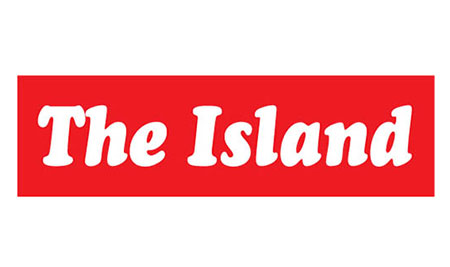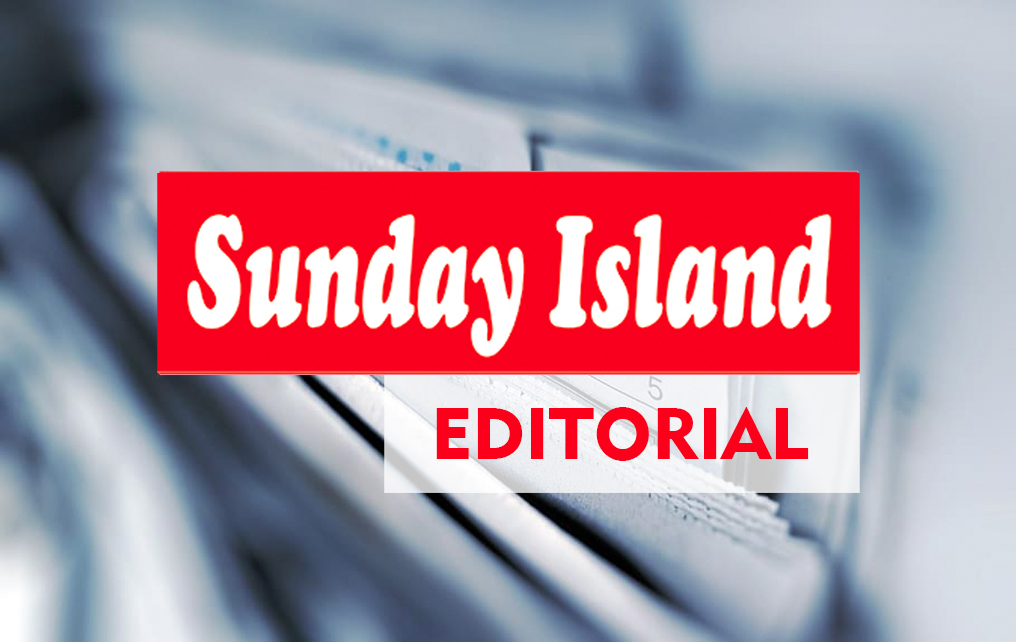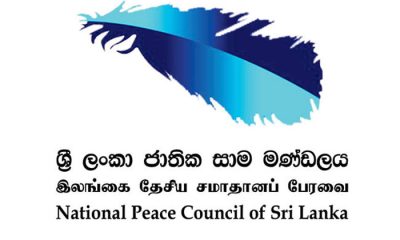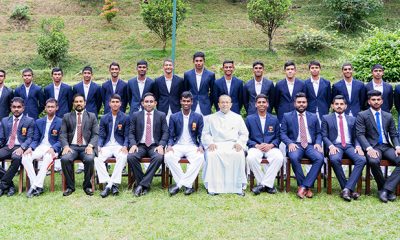Editorial
Gesture of solidarity

Thursday 25th February, 2021
Nothing could be more reassuring and uplifting in times of trouble than a true friend’s presence. Sri Lanka has only a few generous, altruistic friends, and Pakistan certainly is prominent among them. Pakistani Prime Minister Imran Khan’s visit, albeit brief, could not have come at a better time for Sri Lanka, a badger facing a pack of growling mastiffs in Geneva; what it needs most at this juncture is moral support.
Many are the nations that have proffered loads and loads of unsolicited advice to Sri Lanka on how to protect democracy and human rights. But none of them helped remove the scourge of terror, the gravest threat to democracy and humankind. Pakistan stood unwaveringly behind Sri Lanka during the latter’s war on terror and helped the latter in numerous ways. It was the multi-barrel rocket launchers Pakistan rushed here in the aftermath of the fall of Elephant Pass garrison, in 2000, that enabled the Army put the brakes on the ‘unceasing wave’ of the LTTE. Otherwise, the Tigers would have laid siege to Jaffna with ease, forcing the Army to withdraw its troops. (Some countries even offered ships for ferrying soldiers to Colombo!) Today, Sri Lanka is free from political assassinations, massacres, child conscription, etc., as LTTE terrorism has been neutralised. If it had given in to pressure from the Western bloc and spared the LTTE’s military muscle, thousands of lives would have been destroyed during the last 12 years or so.
There were calls, in some quarters, for PM Khan to take up the issue of ‘forced burials’ with Colombo. They were obviously aimed at creating a media feeding frenzy and thereby giving the anti-Sri Lankan campaign in Geneva a boost. Pakistan and Sri Lanka have their own way of sorting out problems; never do they resort to megaphone diplomacy. But, the fact remains that mandatory burials have hurt the Muslim community beyond measure mostly because those who die of COVID-19 are allowed to be buried in other countries including those notorious for their antipathy towards Muslims. Some prominent Sri Lankan medical experts are of the view that the burial of pandemic victims should be permitted, provided the health regulations in place to prevent the spread of the pandemic are strictly followed. Prime Minster Mahinda Rajapaksa, as a sensible leader, must have gone by expert opinion including that of the Sri Lanka Medical Association, when he said in Parliament recently that the burial of COVID-19 victims would become an option. Sadly, he was overruled.
It is significant that the Head of State of a prominent Islamic nation has been to Sri Lanka while the pro-LTTE groups are exerting a considerable pull on a section of the Muslims community who courageously stood up to LTTE terror and thwarted Prabhakaran’s efforts to extend his control over the Eastern Province. Some of the Muslims who became the target of a hate campaign following the Easter Sunday carnage have joined forces with the pro-LTTE political groups masquerading as crusaders for democracy, in the Eastern Province, which is of pivotal importance to the countries that seek to counter increasing Chinese presence here. This is something Sri Lanka and its Islamic allies such as Pakistan should take cognizance of.
Meanwhile, there are many areas where Sri Lanka and Pakistan can partner to realise their full potentials as developing nations. Besides trade, commerce and investment, they can concentrate more on agriculture, construction, science and technology, education, medicine, tourism, etc. PM Khan’s ‘Global Initiative on Debt Relief’ is something that Sri Lanka, as well as other nations in the Global South, should fully support.
There are some issues that Sri Lanka and Pakistan should address jointly. One of them is the narcotic trade, which has affected both countries badly. Drug cartels have established a supply route via Pakistan and Sri Lanka, which has become a narcotic transit point of sorts.
It is a pity that the Sri Lankan Parliament did not have the honour of being addressed by PM Khan, a brilliant orator and trusted friend.
Editorial
Bottom trawling: Right and Might

Indian Prime Minister Narndra Modi’s three-day visit here was predictably heralded by a blaze of publicity in the local press and electronic media. This was no cause for surprise given that good relations with our giant neighbour, or Big Brother as some would prefer to style it, must remain the cornerstone of Sri Lanka’s foreign policy. New Delhi accurately judged in which direction the political winds were blowing well ahead of last year’s presidential and parliamentary elections and invited the soon to be President Anura Kumara Dissanayake to visit India where he was well received. Weeks after being elected president, and scoring a better than two thirds majority in the parliamentary election that followed shortly thereafter, Dissanayake paid a state visit to India, his very first after being elected and was very warmly welcomed.
Prime Minister Modi is now here on a reciprocal visit and has a crowded agenda including a visit to Anuradhapura where he will pay homage to the sacred Jaya Sri Maha Bodhiya, grown from a sapling of the bo tree in India under which the Buddha attained enlightenment; and formally inaugurate the Maho-Anuradhapura railway signaling system and the newly upgraded Maho-Omanthai railway line, both assisted by India. Several memorandums of understanding, including possibly a Defence Co-operation Agreement, kept under wraps at the time of writing this comment, are due to be exchanged. Official word on the subject is that matters to be covered in the MOUs include energy, digitization, security and healthcare along with agreements relating to India’s debt restructuring assistance. But no details have been forthcoming.
Additionally, the visiting prime minister and his delegation who will have bilateral discussions with Sri Lanka’s president is also due to virtually inaugurate several India assisted projects. These include the Sampur solar power plant, the 5,000 mt temperature and humidity controlled cold storage facility in Dambulla and the installation of 5,000 solar panels across 5,000 religious sites here. Sri Lanka cannot forget the massive assistance provided by India in 2022 when this country faced the worst economic crisis in its contemporary history. At that time India provided multi-pronged assistance, including a $4 billion financing package through multiple credit lines and currency support, to help this country sustain essential imports and avoid defaulting on its debts.
Sri Lanka is undoubtedly benefiting from great power rivalry between India and China in the Indian Ocean where India seeks advantages through its Neighbourhood First policy while China seeks leverage through its Belt and Road initiative. The fact that the new Sri Lanka president chose to make his first state visit to India and thereafter follow with a visit to China may be an indication of priorities in Colombo. There is no escaping the reality that all countries must, where foreign relations are concerned, place their own national interest above all other considerations. This is so be it for Sri Lanka, India, China or any other country. Thus while not looking gift horses in the mouth, we must always be conscious that there is no such thing as a free lunch and be protective of our own interests.
Relations between Sri Lanka and India saw both high and low points during this century. The low was during the civil war Sri Lanka waged against the Liberation Tigers of Tamil Eelam (LTTE) in the earlier stages of which India allowed the insurgents to train and base on Indian territory. India, in fact, provided them with weapons and military training and other assistance through its RAW (Research and Analysis Wing). state intelligence agency. It may be argued that the communal disharmony between the Sinhalese and the Tamils that escalated into civil war was a problem of Sri Lanka’s own making and sub-regional sentiment in Tamil Nadu greatly influenced New Delhi’s hand in intervening.
Relations thereby plummeted and were restored to a point by the signing the Indo- Sri Lanka Peace Accord between President J.R. Jayewardene and Prime Minister Rajiv Gandhi in July 1987. With two insurrections raging in the north and south of the country, Jayewardene had no option but seek Indian assistance on India’s terms. What followed including Rajiv Gandhi’s assassination, as he campaigned for re-election as India’s prime minister is contemporary history that requires no elaboration. But since then, in the post 2022 situation when Sri Lanka faced an unprecedented economic crisis and was forced to declare bankruptcy, India came to our rescue with massive assistance and relations between the two countries have never been better.
At this point of time when Sri Lanka is headed in a new political direction under new leadership, will it be possible for the greatest irritant in present Indo-Lanka relations – bottom trawling by Indian fishermen poaching in Sri Lanka waters and destroying the marine environment – to be conclusively resolved? India has always adopted the position that this issue must be resolved in what she calls a “humanitarian manner.” It is undoubtedly a livelihood issue for fishermen – on both sides. Indian fishermen enjoyed free rein on the Sri Lanka side of the International Maritime Boundary during the war when Lankan fishermen were prohibited from going into deep sea. The Indians claim fishing in our waters to be their “traditional right.”
Prime Minister Modi’s party attempted to win votes in Tamil Nadu during the last election by accusing the Congress of “ceding” Kachchativu to Sri Lanka. The right on this issue is on our side while the might is on India’s. In the midst of honeyed words that will be much of the picture during until Sunday when the visit ends, result in might conceding to right? Even at least as far as stopping bottom trawling, illegal on our side though not in India’s goes?
Editorial
Dulling the pangs of hunger

Saturday 5th April, 2025
The government has, with the help of the National Food Promotion Board, the Ministry of Health and the Ministry of Agriculture, launched a programme to provide the public with nutritious food at reasonable prices as part of its Clean Sri Lanka initiative. The public, fleeced by private eatery owners ruthlessly, will surely benefit from this programme, which deserves praise. It will also help improve the government’s approval rating significantly. A way to a person’s heart is said to be through his or her stomach.
A widely-held misconception is that every prospect pleases in this country, and only politicians are vile. True, most politicians are thought to be bad, but it is not fair to single them out for castigation. There are many others who are either equally bad or even worse. The blame for people’s hardships due to the high cost of living should be apportioned to the business community, given to unconscionably exploitative practices; its members, from wayside eatery owners to corporate fat cats, jack up the prices of their products and services according to their whims and fancies, at the expense of the public. The rice millers have become a law unto themselves.
Why food inflation is high is not difficult to understand. A plain hopper is priced at Rs. 25, and an egg costs about Rs. 30 at present, but an egg hopper is sold at Rs. 100! Food prices that went into the stratosphere at the height of the economic crisis in 2022 have not come down significantly owing to the greed of the unscrupulous members of the business community.
The government initiative to make quality food available at reasonable prices to the public should continue, and it is hoped that the NPP leaders will also develop the Hela Bojun Hala (HBH) restaurant chain under the Ministry of Agriculture. These eating places not only sell nutritious food made from local ingredients at very reasonable prices but also economically empower women. All HBH outlets are run by women and do not sell wheat flour products or sugary drinks.
The NPP government can give a turbo boost to the HBH programme by expanding it across the country. That will help provide direct employment to many more women. Sri Lanka’s overall unemployment rate is 4.7%, and about 6.7% women are unemployed. Besides, during gluts, fruit and vegetable growers often dump their unsold produce on the roadside in protest. The government may be able to use the HBH network to help the farming community while generating employment opportunities and providing the public with quality food at affordable prices.
Minister of Agriculture K. D. Lalkantha, known for innovative thinking and hard work, was the chief guest at the recent launch of the aforesaid food programme. He should take time off from pursuits such as counting monkeys and give serious thought to developing the HBH network further so that more people will have access to reasonably-priced, hygienic, and nutritious foods, and more jobs can be created for women, and men as well if a home delivery service is set up at the HBH outlets.
Sri Lanka’s political culture is such that when a new government is elected it launches its own programmes and either scrap the ones introduced by its predecessor or let them wither on the vine. It is hoped that the NPP government will be different and develop the HBH programme, which has become a success.
Editorial
Trump’s pound of flesh and bleeding nations

Friday 4th April, 2025
US President Donald Trump has jacked up tariffs on imports in the name of making America wealthy again. Yesterday, he signed an executive order, with his usual melodrama, increasing tariffs on goods imported from many countries including Sri Lanka, which will now have to pay as much as 44% by way of tariff on its exports to the US. Claiming that the unprecedented tariff hike is a reciprocal measure, Trump has said the new 44% tariff is in response to Sri Lanka’s 88% trade barriers on American goods. It is a case of a giant competing with a dwarf!
Powerful nations are resilient enough to absorb the US tariff shocks, but the weaker economies like Sri Lanka are bound to reel and even go into a tailspin, causing further destabilisation of the developing world. The US tariff hike will deal a body blow to Sri Lanka’s export sector, especially its garment industry, which is showing signs of recovery. Sri Lankan goods, especially garments, will now be less competitive in the US market. Other Asian garment exporters, such as India, Bangladesh and Vietnam, also have higher US tariffs to contend with but not to the same extent as Sri Lanka. There’s the rub.
A drastic decline in export earnings due to the new US tariffs will invariably lead to a decrease in Sri Lanka’s foreign currency reserves, causing a further depreciation of the rupee, an increase in inflation, job losses, and even socio-political upheavals unless the US takes the fragile condition of the Sri Lankan economy and softens its stand.
President Anura Kumara Dissanayake has appointed an expert committee to study the economic fallout of the US tariff hike and recommend remedial measures. This is a step in the right direction, and it is hoped that the government, together with all other stakeholders, will be able to formulate a mitigatory strategy to cushion the impact of the new US tariffs on the local industries and the ailing economy. Most of all, the government will have to manage the country’s foreign currency reserves frugally.
What the US can gain from the unprecedented hike in tariffs on Sri Lankan exports is negligible, and it will not give any significant boost to the US economy or industries. Is Washington trying to leverage Sri Lanka’s overdependence on the US as an export destination to further its geopolitical interests in a bigger way? Is the Trump administration goading Sri Lanka into a situation where the latter will be left with no alternative but to agree to anything including controversial agreements, owing to its sheer desperation to have the US tariffs on its exports reduced?
If what Trump said, while announcing the new tariffs is anything to go by, he wants to make America wealthy again by creating conditions for the domestic industries to be ‘reborn’. But he has apparently ignored factors like stringent environmental laws, higher cost of domestic labour, increases in raw material costs due to new tariffs, technological competition, etc., which will stand in the way of the US in achieving his dream.
Whether Trump will be able to realise his MAGA (Make America Great Again) goal by resorting to ruthless actions that weaken the economies in the developing world may be in doubt, but one possible outcome of his tariff war, as it were, is not difficult to predict. Extremely high tariffs the US has imposed on imports are at variance with the liberal economic principles and policies it has long championed. Such excessively protectionist measures could undermine America’s global dominance, driving smaller nations to gravitate towards its rivals in search of favourable trade terms. Russia lost no time in offering to help Sri Lanka’s export sector. Other powerful nations are likely to follow suit where the developing countries troubled by the US tariffs are concerned.
-

 Business2 days ago
Business2 days agoStrengthening SDG integration into provincial planning and development process
-

 News6 days ago
News6 days agoBid to include genocide allegation against Sri Lanka in Canada’s school curriculum thwarted
-

 Business1 day ago
Business1 day agoNew SL Sovereign Bonds win foreign investor confidence
-

 Sports3 days ago
Sports3 days agoTo play or not to play is Richmond’s decision
-

 Business1 day ago
Business1 day agoDaraz Sri Lanka ushers in the New Year with 4.4 Avurudu Wasi Pro Max – Sri Lanka’s biggest online Avurudu sale
-

 Latest News5 days ago
Latest News5 days agoIPL 2025: Rookies Ashwani and Rickelton lead Mumbai Indians to first win
-

 News6 days ago
News6 days agoSL needs a comprehensive solution, not selective justice: NPC
-

 Sports4 days ago
Sports4 days agoTrinity, St. Anthony’s out to end decade long victory drought











